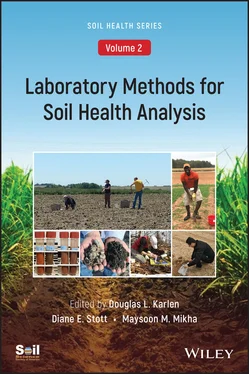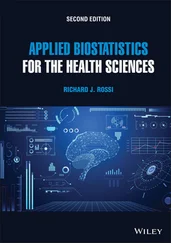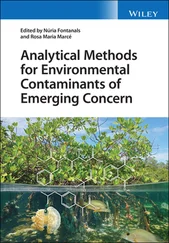Laboratory Methods for Soil Health Analysis, Volume 2
Здесь есть возможность читать онлайн «Laboratory Methods for Soil Health Analysis, Volume 2» — ознакомительный отрывок электронной книги совершенно бесплатно, а после прочтения отрывка купить полную версию. В некоторых случаях можно слушать аудио, скачать через торрент в формате fb2 и присутствует краткое содержание. Жанр: unrecognised, на английском языке. Описание произведения, (предисловие) а так же отзывы посетителей доступны на портале библиотеки ЛибКат.
- Название:Laboratory Methods for Soil Health Analysis, Volume 2
- Автор:
- Жанр:
- Год:неизвестен
- ISBN:нет данных
- Рейтинг книги:3 / 5. Голосов: 1
-
Избранное:Добавить в избранное
- Отзывы:
-
Ваша оценка:
- 60
- 1
- 2
- 3
- 4
- 5
Laboratory Methods for Soil Health Analysis, Volume 2: краткое содержание, описание и аннотация
Предлагаем к чтению аннотацию, описание, краткое содержание или предисловие (зависит от того, что написал сам автор книги «Laboratory Methods for Soil Health Analysis, Volume 2»). Если вы не нашли необходимую информацию о книге — напишите в комментариях, мы постараемся отыскать её.
Analyzing, comparing, and understanding soil health data Soil Health, Volume Two: Laboratory Methods for Soil Health Analysis
Laboratory Methods for Soil Health Analysis, Volume 2 — читать онлайн ознакомительный отрывок
Ниже представлен текст книги, разбитый по страницам. Система сохранения места последней прочитанной страницы, позволяет с удобством читать онлайн бесплатно книгу «Laboratory Methods for Soil Health Analysis, Volume 2», без необходимости каждый раз заново искать на чём Вы остановились. Поставьте закладку, и сможете в любой момент перейти на страницу, на которой закончили чтение.
Интервал:
Закладка:
7 Weigh 50 mg of soil into an aluminum tin capsule using an analytical scale with 0.001 precision.
8 Fold the aluminum tin capsule containing the soil sample and load it on to the analyzer.
9 Weigh a known standard to serve as a check, using one standard every 12 to 20 samples. Standards can either be EDTA, aspartic acid, or soil with a known concentration of C.
* The operation of the analyzer should be operated according to the guidelines of the machine.
Loss‐On‐Ignition (LOI) (Salehi et al., 2011; Schulte and Hopkins, 1996)
Apparatus
1 20 mL porcelain crucibles
2 Forceps
3 2000 μm sieve
4 50 mL beaker
5 Desiccator
6 Muffle
7 Analytical balance
Procedures
1 Air dry or oven‐dry soil at 35 to 40 °C.
2 Carefully remove all plant and animal materials from the soil using forceps.
3 Pass the soil through a 2000 μm sieve.
4 Weigh 10 ( ± 0.05) g of the soil sample in a tared 50 mL beaker and oven‐dry at 105 °C overnight. This process will ensure the removal of all water from the gypsum in gypsiferous soils.
5 Using a desiccator, cool the samples and then record the weight.
6 Transfer the oven‐dry soil (~10 ( ± 0.05) g) into a porcelain crucible, heat the samples in a muffle furnace for 2 h at 360 °C (after the temperature reaches 360 °C).
7 After the combustion, cool the samples to 150 °C in a desiccator before reweighing and recording the value
Calculation
SOM LOI= [(soil weight after combustion – oven – dry soil weight) / (oven – dry soil weight) * 100]
Soil Inorganic C
Dry combustion Procedure
1 Follow step 11 to 13 of the method for SOC to determine total soil carbon.
2 Follow step 1 to 13 of the method for SOC.
3 Soil inorganic carbon is calculated as the difference between total soil carbon and SOC.
Other Analytical Methods and Issues Affecting Soil Carbon
Gravimetric method for loss of carbon dioxide (Loeppert and Suarez, 1996)
Apparatus
1 50 mL Erlenmeyer flask
2 Analytical balance
3 10 mL and 250 mL pipettes or dispensers
Reagents
1 Hydrochloric acid (HCl), 3 M. Transfer 250 mL of concentrated HCl to 500 mL of deionized water and dilute to a total volume of 1 L.
Procedure
1 Weigh a stoppered, 50 mL Erlenmeyer flask containing 10 mL of 3 M HCl.
2 Transfer a 1 to 10 g air‐dried soil sample (containing 0.1–0.3 g of CaCO3 equivalent) to the container, a little at a time, to prevent excessive frothing.
3 After effervescence has subsided, replace the stopper loosely on the flask and swirl the flask occasionally for about 15 min.
4 At intervals of about 15 min, remove the stopper and swirl the flask for 10 to 20 s to displace any accumulated CO2 with air.
5 Replace the stopper and then weigh the flask and its contents to the nearest 0.1 mg.
6 Repeat the agitation and weighing procedure until the weight of the container does not change by more than 1 to 2 mg. The reaction is usually complete within 1 h.
Calculation
1 Weight of CO2 = Difference between initial and final weights (flask + stopper + acid + soil)

Biochar
Biochar is a bioproduct from a thermochemical conversion (pyrolysis) of biomass (Koide et al., 2011). Biochar may be used as a soil amendment due to its chemical and physical characteristics, and because of its potential to help mitigate climate change. Sequestering biochar carbon in soil contributes greatly to reducing greenhouse gas emissions (Leng et al., 2019). Biochar has a high concentration of recalcitrant carbon that is resistant to decomposition (Glaser et al., 2002), but since a portion of most fresh biochar is easily decomposable (Lehmann and Joseph, 2015), and repeated analyses and applications of biochar may be necessary.
Due to its chemical complexity and large variability, a simple routine way to quantify biochar in soils is still scarce and under investigation, mainly because of the difficulty in distinguishing biochar from other forms of soil organic matter. Methods to evaluate biochar in soils are extremely labor intensive or need specialized instrumentation. According to Leng et al. (2019), biochar in soils has been quantified by scanning calorimetry, nuclear magnetic resonance spectroscopy or infrared spectroscopy, analysis of molecular markers, or by preferential removal of inorganic and non‐biochar organic C by selective oxidation or acid treatment followed by the analysis of residual organic material by NMR, optical, or mass spectroscopy, or thermal conductivity.
SOC Stocks: Considerations on Sampling Depth and Mass Corrections
Soil carbon stocks are commonly quantified at fixed depths as the product of soil bulk density, depth, and organic carbon (OC) concentration. Soil C stocks are estimated using the following equation:

C is the organic C stock in the soil layer (Mg ha –1); OC is the total organic C content in the soil layer (%); Ds is the soil density in the soil layer (Mg m –3), and E is the thickness of the sampled layer (cm). However, this method systematically overestimates SOC stocks in samples from areas with a higher bulk density, such as minimum tillage, thus exaggerating their benefits. This is not to discourage the use of such calculations, but rather to build awareness that estimates of real SOC change can be greatly compromised if bulk densities differ among treatments or over time.
References
1 Albrecht, W. 1938. Soils and men: Yearbook of agriculture. USDA, Washington, D.C.
2 Balesdent, J., C. Chenu, and M. Balabane. 2000. Relationship of soil organic dynamics to physical protection and tillage. Soil Tillage Res. 53:215–230. doi:10.1016/S0167‐1987(99)00107‐5
3 Barthès, B., and E. Roose. 2002. Aggregate stability as an indicator of soil susceptibility to runoff and erosion; validation at several levels. Catena 47:133–149. doi:10.1016/S0341‐8162(01)00180‐1
4 Bell, M., and D. Lawrence. 2009. Soil carbon sequestration—myths and mysteries. T.G. Trop. Grassl. 43:227–231.
5 Benito, E. and F. Diaz‐Fierros. 1992. Effects of cropping on the structural stability of soils rich in organic matter. Soil and Tillage Research, 23:153–161. doi.org/10.1016%2F0167‐1987%2892%2990011‐y
6 Bonini Pires, C., T. Amado, G. Reimche, R. Schwalbert, M. Sarto, R. Nicoloso, J.E. Fiorin, and C.W. Rice. 2020. Diversified crop rotation with no‐till changes microbial distribution with depth and enhances activity in a subtropical Oxisol. Eur. J. Soil Sci. 71: (In Press). doi:10.1111/ejss.12981
7 Boyle, M., W.T. Frankenberger, and L.H. Stolzy. 1989. The influence of organic matter on soil aggregation and water infiltration. J. Prod. Agric. 2:290–299. doi:10.2134/jpa1989.0290
8 Broadbent, F.E., and J.B. Ott. 1957. Soil organic matter‐metal complexes: 1. Factors affecting retention of various cations. Soil Sci. 83:419–428. doi:10.1097/00010694‐195706000‐00001
9 Bünemann, E., G. Bongiorno, Z. Bai, R. Creamer, G. De Deyn, R. de Goede, L. Fleskens, V. Geissen, T.W. Kuyper, P. Mäder, M. Pulleman, W. Sukkel, J.W. van Groenigen, and L. Brussaard. 2018. Soil quality– A critical review. Soil Biol. Biochem. 120:105–125. doi:10.1016/j.soilbio.2018.01.030
Читать дальшеИнтервал:
Закладка:
Похожие книги на «Laboratory Methods for Soil Health Analysis, Volume 2»
Представляем Вашему вниманию похожие книги на «Laboratory Methods for Soil Health Analysis, Volume 2» списком для выбора. Мы отобрали схожую по названию и смыслу литературу в надежде предоставить читателям больше вариантов отыскать новые, интересные, ещё непрочитанные произведения.
Обсуждение, отзывы о книге «Laboratory Methods for Soil Health Analysis, Volume 2» и просто собственные мнения читателей. Оставьте ваши комментарии, напишите, что Вы думаете о произведении, его смысле или главных героях. Укажите что конкретно понравилось, а что нет, и почему Вы так считаете.












